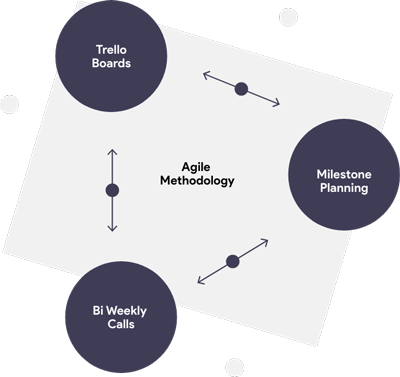Logistics App For PayPoint
Logistics App For PayPoint
- 1
Strategy
After discussing with the partner, we devised a strategy based on the time and material model, with sprints set for each milestone, to restructure the UI/UX of a payments application to facilitate it to extend its services sector.
- 2
Analysis Planning
As the existing application was originally built on React Native, we aligned our choice of tech stack with the same to develop the Frontend of the application
- 3
UI/UX
On the design front, we implemented the perfect designs to suit the UI/UX of the PayPoint application as per our client’s demands.
- 4
Development
We implemented core and additional features such as login/registration, driver delivery and customer collection screens alongside implementing Firebase Analytics to allow the tracking of app usage and user engagement.
- 5
Testing
At the end of each sprint, the finished product was delivered to the client for UAT and feedback was collected to make the app more stable.
- 6
Delivery
The project is currently ongoing after a period of three years, with new features being introduced to the PayPoint’s application at regular intervals.
Since its establishment in 1996, PayPoint has come a long way from providing prepayment energy and electricity meters to customers at local convenience stores to providing multi-channeled payment solutions to clients and customers across Ireland, London, and Romania. With its continuous growth and inclusion in the London Stock Market, there were even more horizons the company wanted to cover. One of them was Collect+, a parcel collection system to promote ease of access in delivery and distribution. Keeping up with the current Smartphone trend, Andrew Lewis, the head of Product Development at PayPoint wanted an app that could put these cogs into motion and yet again, expand the company's functions.
Andrew first reached out to us in April, 2018 with a requirement of an application made in React Native to facilitate the Collect+ division of PayPoint. The idea was to facilitate courier and parcel pickup for customers at the comfort of their smartphones so that they can track their goods and collect them at their own convenience. His needs were clear, needing Front-End development and a flawless UX design. The Business Development team jumped on the scene and took charge.
A couple of meetings about the intricacies of the project, including the engagement model to be used, documentations and a quick overview of the organization were held and our office in the UK got in touch for a Face-to-Face meeting with Andrew to discuss long-term engagements. With every stoned turned and every detail addressed, Andrew decided to invest his trust into us and it marked the beginning of a beautiful relationship.
The first task at hand was to decide a team that would be at Andrew's disposal to make his app a reality. The app was to feature a simple order placing, tracking and collection system with verification and security add-ons. Aditya Kumar was assigned the task to make this application function the way it was supposed to. For the UI/UX design, Megha and her team of designers were deployed, with the aim to create a fluidic UX that felt natural. Upon mutual agreement, completion of the first phase was decided to be under a fixed plan of two months, with two weeks alloted to the UX team to deliver.
Designing the UX of the application.
Designing and building UI for Login/Registration, Driver Delivery and Customer collection screens.
Successful Integration of UI elements with API’s.
Addition of Firebase Analytics for an insight on app usage and user engagement.
Sorting deployment environment for app in iOS and Android.
Building UI and integration process for Inventory Scanning and Parcel Refusal.
Customer Collections
Customer Send
Driver Delivery
Driver Delivery Ebay
Theme and Designs

There was extra attention given to the readability of code and to assist deployment, all the necessary configurations were automated. The QA team was hyper-active in providing constructive feedback and testing the application to an atomic level to produce bugs which further improved the quality of the app on the whole. As an additional added value, Aditya decided to make the UI of the app scalable, which pushed the development speed to be faster and also added a crash reporting system which simplified identification and resolution of bugs.
In parallel, the UX team was working tirelessly to create the perfect UX that would deem worthy of the functions of the app and accentuate them, just the right amount, for the users. Since, PayPoint was not a traditional e-commerce application, there were a lot of changes made to the wireframes of designs that were to be implemented for the app. Also, the different features of the app were a tough nuts to crack but that wasn't enough to keep the team from making it impeccable.
One of the functions of the app was to scanning and identification of parcels upon arrival and delivery. This particular function required the implementation of text as well as barcode scanners wherever applicable, which was a challenge to implement during development. The optimal way to overcome this obstacle came in the form of implementing a library that provided text and barcode scanning facility and careful addition of validation of the respective data that would separate the two based on scenarios.
- QA Processes were hand led by the QA team at PayPoint.
- Environment Management was handled by -react-native-config.
- JIRA was the chosen configuration manager.
- BitBucket helped with Version Controlling of the releases.
PayPoint was impressed with the GeekyAnts team's work and they made it clear in their mails to the team. They were impressed by the overall work of the team and their ability to produce fixes to problems fast as well as their throughput rate which allowed them to move things faster that originally planned, which is always a plus point. Our work allowed PayPoint to further expand their service avenues in the UK and enabled them to put the process into action a lot faster that they had anticipated. The first phase of the project was completed on time and presently, further phases and long-term engagements are being planned with the client.








